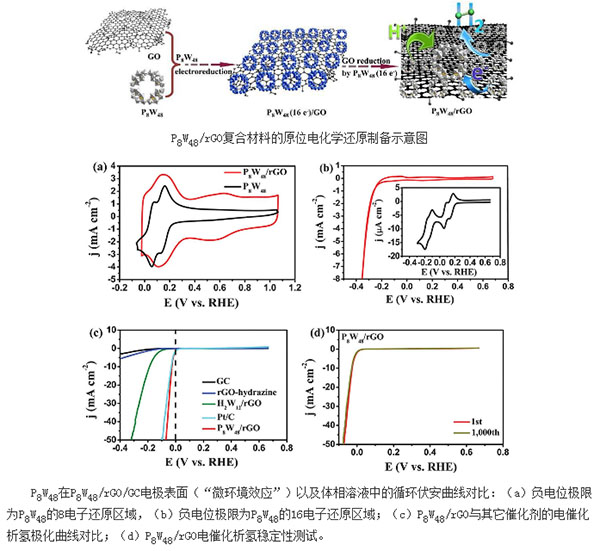As early as the 1980s, American scientists proposed that when an electrocatalyst (or electroactive material) is immobilized on an electrode or in a three-dimensional conductive structure material, a microenvironment is formed, which shows the electrochemical properties and the bulk state ( That is, when dispersed in a solution, it will show a huge difference, that is, a "micro-environmental effect." However, so far no one has found strong experimental evidence for this effect. Recently, the research team of Zhang Guangjin, a researcher in the Department of Green Chemistry Engineering of the Institute of Process Engineering, Chinese Academy of Sciences, has discovered that a poly-acid-graphene nanocomposite has obvious "micro-environmental effects" and reflects excellent electrocatalytic hydrogen evolution performance. They selected macrocyclic heteropolyacids containing 48 W atoms (K28Li5[H7P8W48O184] • 92H2O, abbreviated as P8W48) as the object of investigation. This is mainly due to the fact that this polyacid has good multi-electron and proton storage capabilities. And in acidic conditions are very stable, easy to large-scale preparation and so on. At the same time, based on the good electron transport capability of graphene, reduced graphene oxide (rGO) can be obtained by reduction of graphene oxide in aqueous solution using polyacid as a reducing agent. They designed and developed a one-step in situ electrochemical reduction method to prepare P8W48/rGO composites. Through this method, P8W48 was uniformly dispersed in a single molecule and fixed on the surface of rGO to form a three-dimensional topological composite. Combined with XPS, solid-state NMR and theoretical calculations, it is found that there is a strong interaction between P8W48 and rGO, so that electrons and protons can be efficiently exchanged between the catalyst and the carrier. Due to the high efficiency of electron and proton storage and transfer properties of this composite catalyst, the cyclic voltammogram curve study shows that P8W48 has a significant “microenvironmental effect†on the electrode by immobilizing the composite on a glassy carbon electrode. The material shows a very strong protonation ability. Therefore, the material exhibits extremely high electrocatalytic hydrogen evolution performance: only 28mV of overpotential is required at a hydrogen evolution current density of 10 mA cm-2, which is superior to all non-precious metal catalysts currently reported and commercialized. The 20wt.% Pt/C catalyst is equivalent; the electrocatalytic hydrogen evolution Faradaic efficiency reaches 100%. The research collaborator Ulrich Kortz of the University of Bremen, Germany, performed the synthesis of P8W48 polyacids. Professor Naresh S. Dalal of Florida State University conducted a solid-state nuclear magnetic characterization of the composites. Professor Yan Lijun of Northeast Normal University conducted composite materials. Theoretical simulation calculations. The study was supported by the National Natural Science Foundation of China (21371173, 51402298, 91545125), the Postdoctoral Science Foundation (2014M550846), and the "International Talents Program" of the Chinese Academy of Sciences (2015VMA041). The results of relevant studies are published in the International Energy Environment Journal “Energy and Environment Science†(Energy Environ. Sci., 2016, DOI: 10.1039/C5EE03503A). Dumbwaiter Lift,Dumbwaiter Elevator,Elevator Lift,Small Elevators For Homes Homefriend&FUJI Elevator Co.,Ltd , https://www.jfujilift.com